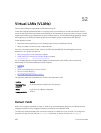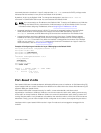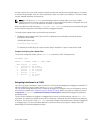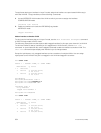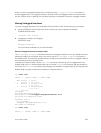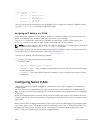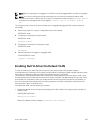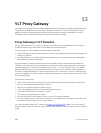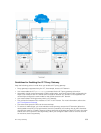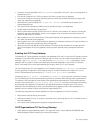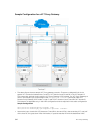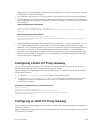
NUM Status Q Ports
* 1 Inactive
2 Active T Po1(So 0/0-1)
T Te 1/3/1
3 Active T Po1(So 0/0-1)
T Te 1/1/1
4 Active U Te 1/2/1
The only way to remove an interface from the Default VLAN is to place the interface in Default mode by
using the no switchport command in INTERFACE mode.
Assigning an IP Address to a VLAN
VLANs are a Layer 2 feature. For two physical interfaces on different VLANs to communicate, you must
assign an IP address to the VLANs to route traffic between the two interfaces.
The shutdown command in INTERFACE mode does not affect Layer 2 traffic on the interface; the
shutdown command only prevents Layer 3 traffic from traversing over the interface.
NOTE: You cannot assign an IP address to the Default VLAN (VLAN 1). To assign another VLAN ID to
the Default VLAN, use the default vlan-id vlan-id command.
In Dell Networking OS, you can place VLANs and other logical interfaces in Layer 3 mode to receive and
send routed traffic. For more information, refer to Bulk Configuration.
To assign an IP address, use the following command.
• Configure an IP address and mask on the interface.
INTERFACE mode
ip address ip-address mask [secondary]
– ip-address mask — Enter an address in dotted-decimal format (A.B.C.D) and the mask must be
in slash format (/24).
– secondary — This is the interface’s backup IP address. You can configure up to eight secondary
IP addresses.
Configuring Native VLANs
Traditionally, ports can be either untagged for membership to one VLAN or tagged for membership to
multiple VLANs.
You must connect an untagged port to a VLAN-unaware station (one that does not understand VLAN
tags), and you must connect a tagged port to a VLAN-aware station (one that generates and understands
VLAN tags).
Native VLAN support breaks this barrier so that you can connect a port to both VLAN-aware and VLAN-
unaware stations. Such ports are referred to as hybrid ports. Physical and port-channel interfaces may be
hybrid ports.
Native VLAN is useful in deployments where a Layer 2 port can receive both tagged and untagged traffic
on the same physical port. The classic example is connecting a voice-over-IP (VOIP) phone and a PC to
the same port of the switch. The VOIP phone is configured to generate tagged packets (with VLAN =
VOICE VLAN) and the attached PC generates untagged packets.
936
Virtual LANs (VLANs)





